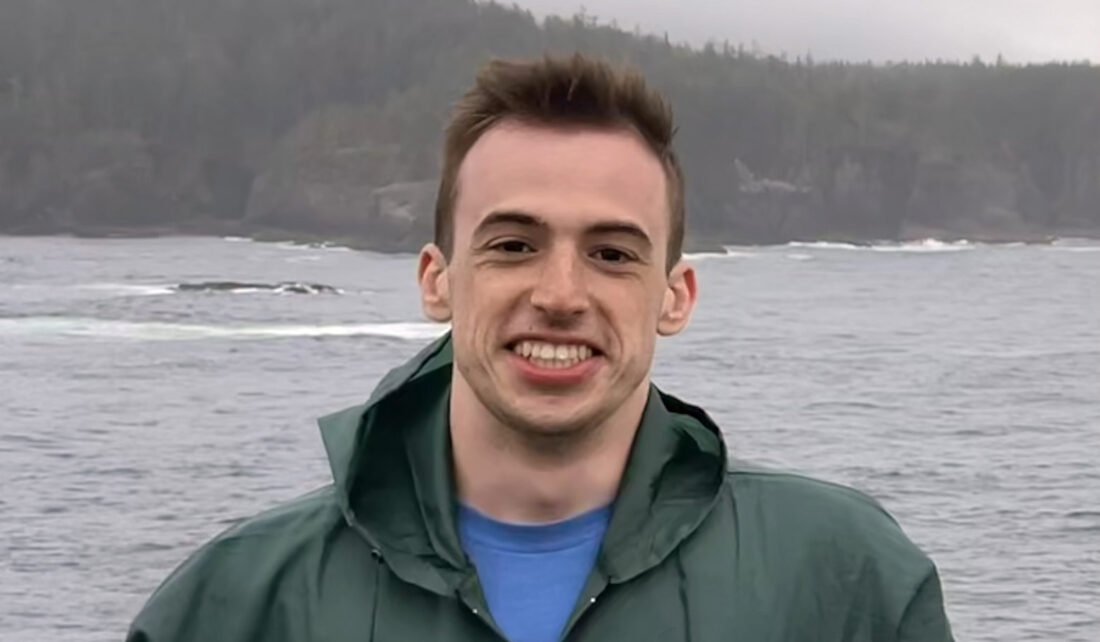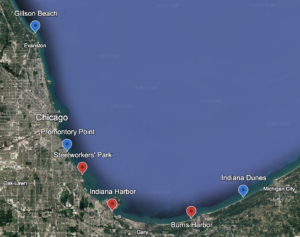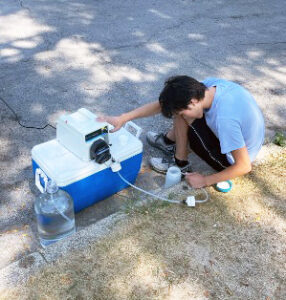
Meet Our Grad Student Scholars is a series from Illinois-Indiana Sea Grant (IISG) celebrating the students and research funded by our scholars program. To learn more about our faculty and graduate student funding opportunities, visit Fellowships & Scholarships.
Max Murray is a second-year PhD student in the Department of Ecology and Evolution at the University of Chicago. He works in the Pfister Lab studying aquatic microbial ecology. The project funded by IISG takes place in the Coleman Lab and investigates the effects of pollution on the activity of Lake Michigan’s nearshore microbial communities.
In August 2023, I packed a van and moved from Ann Arbor, Michigan to Chicago, Illinois to begin graduate school. While it wasn’t necessarily my highest priority, I was expecting to get a nice view of one of my intended study systems, Lake Michigan, along the way. However, as anyone who has driven westbound along the lake’s southern coast can attest, these views are haunted by ghosts of once-thriving industry and the resulting pollution. It can feel impossible at points to see the water through the steel mills and smokestacks. While disappointed, I filed this experience away until I began thinking about what my proposal for the Illinois-Indiana Sea Grant Graduate Scholars program would look like.
Given my background working on the ecological fallout of anthropogenic environmental impacts, I began to formulate some questions about industrial pollution along Lake Michigan’s south shore and decided to investigate further. Through some research and conversations with University of Chicago undergraduate Daniel Arad, I learned that parts of the existing lakeshore were actually artificially built to host the massive industrial campuses that reside there today. Much of the lake was filled in with slag, a byproduct of steel manufacturing that can contain toxic chemicals. So not only have manufacturers dumped industrial waste into the lake for over a century, but their plants themselves are built on acres of slag that constantly releases toxic alkaline leachate into the water column.
Any environmental matrix hosts microbial life, and the waters of Lake Michigan are no exception. The lake’s microbial communities exhibit bottom-up control on the ecosystem by acting as the base of the food web. As a result of their short generation times, sensitivity,

Map of sampling locations: clean sites in blue, polluted sites in red
and sheer quantity (one milliliter of lake water contains thousands of cells), aquatic microbes are a useful lens through which we can study the ecological effects of pollution.
With this in mind, Professor Maureen Coleman, Daniel, and I set out to study how the last century of industrial contamination affects Lake Michigan’s microbial life, and by proxy the broader ecosystem. We designed a “gradient of impact” by sampling at public beaches that vary in proximity to the south shore’s high concentration of lakefront manufacturing. Our “clean” sites are beaches in Evanston, Illinois, Chicago’s Promontory Point, and Indiana Dunes National Park; our “polluted” sites are near Indiana Harbor in East Chicago and at Burns Harbor (both in Indiana), and Steelworkers’ Park on Chicago’s south side.

University of Chicago undergraduate Daniel Arad filtering lake water from Promontory Point.
At each site, Daniel and I collected water and sediment samples to analyze for alkalinity, toxic metals, and organic pollutants (like PCBs, a common “forever chemical”). We also used a pump to push several liters of lake water through extremely fine filters that collect the water’s microbes. Because we immediately froze those filters in liquid nitrogen (-320 ºF), we preserved each cell in the same metabolic state as when they were in their normal environment. This means that when we sequence the RNA (the intermediate step between DNA and proteins) on a filter, we will get a snapshot of how the water’s microbial community is reacting to its surroundings.
With metabolic activity information from each sample, we can then analyze the effect of pollution in many ways. We will ask which genes are more commonly expressed in the presence of certain toxins, which species are more active in contaminated water, and whether pollutants inhibit or encourage community metabolic activity. From there, we can extrapolate and form hypotheses about the broader ecosystemic effects of the south shore’s long history of industrial pollution.
While enormous damage has already been done to this region as well as the other Great Lakes, it is important to remember that we can still have success in restoring our ecosystems. The once ablaze Cuyahoga River, a Lake Erie tributary, now supports populations of dozens of fish species that are safe to eat. Charismatic piping plovers have returned to the Great Lakes’ shorelines, as have lake sturgeon to their waters. We hope to characterize the extent of the south shore’s industrial pollution in a novel manner, thereby jumpstarting a similarly successful ecological restoration effort to clean up the southern shoreline of Lake Michigan.
___________________________________________________________________________
Illinois-Indiana Sea Grant is one of 34 Sea Grant programs supported by the National Oceanic and Atmospheric Administration in coastal and Great Lakes states that encourage the wise stewardship of our marine resources through research, education, outreach and technology transfer. In partnership with the University of Illinois Extension, and Purdue University Forestry and Natural Resources, Illinois-Indiana Sea Grant brings science together with communities for solutions that work.

